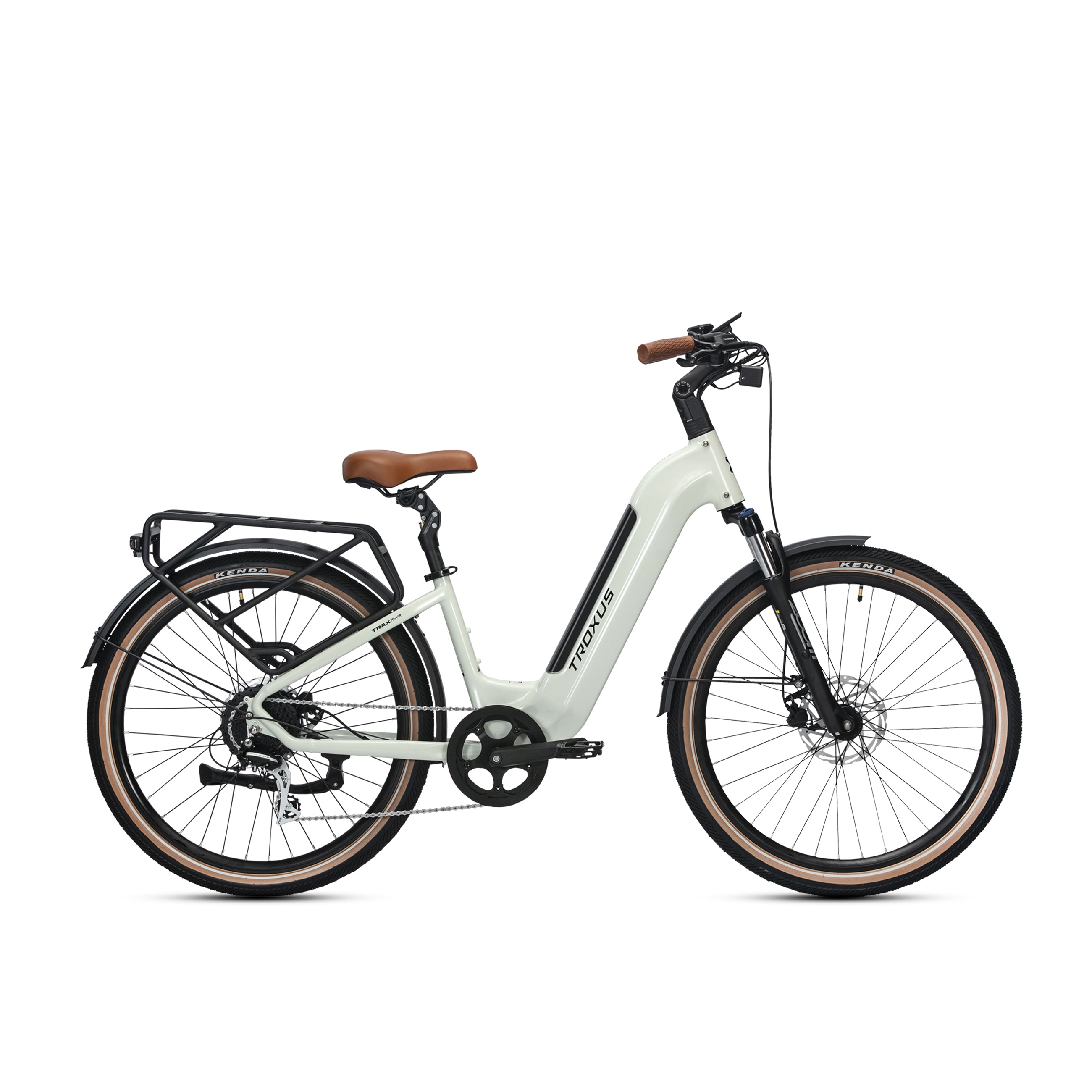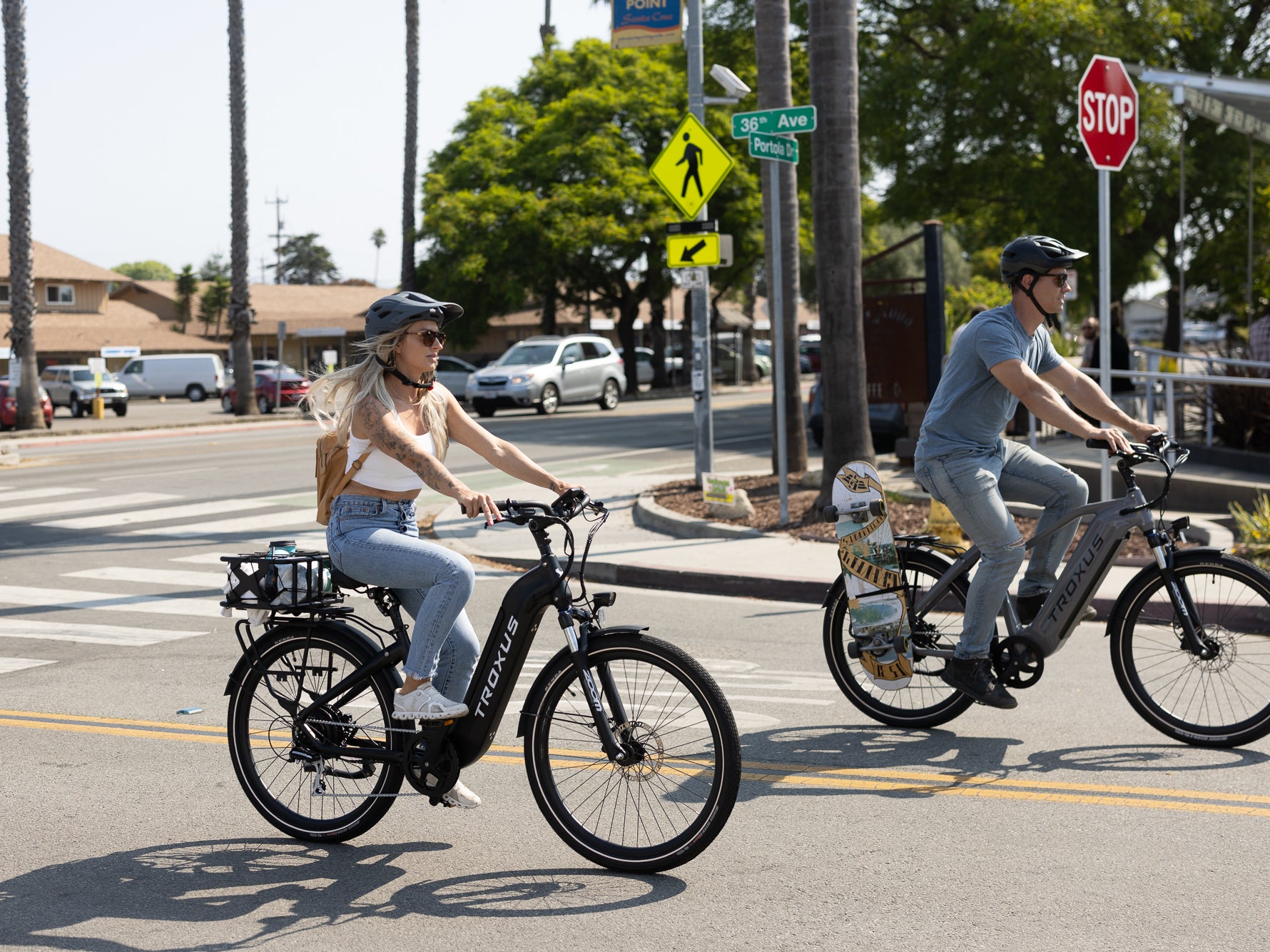In the global quest for sustainable living, urban mobility stands as a keystone area for ecological transformation. The quiet hum of electric motors navigating through city streets is just one part of an rising harmony signals a future that is a greener, more efficient future. Electric bikes, or e-bikes, have surged in popularity, offering more than just a fun way to get around—they are transforming the urban landscape. From reducing carbon footprints and congestion to redefining personal mobility, the electric bike revolution is a narrative of progress and promise.
Content
The Rise of Eco-Friendly Commuting
Electric Bikes vs. Bikes vs. Cars
Electric Bikes and Urban Transportation
Challenges and Solutions in the Electric Bike Expanse
Choosing The Right Commuter Electric Bike
The Rise of Eco-Friendly Commuting
Commuting has long been linked with traffic congestion, environmental pollution, and often, a sense of frustration. However, the emergence of electric bikes is reshaping this story. With a battery-powered motor, electric bikes introduce a pedal-assist system that significantly reduces the effort required, especially during uphill climbs and long journeys. This blend of classic cycling and light electric vehicle technology provides urban riders with an appealing means to navigate through city landscapes with speed and ease.
According to reports from The Conversation, electric bikes and mopeds are reducing demand for oil significantly more than electric cars worldwide. U.S. researchers suggest that if e-bike trips constituted 11% of all vehicle trips, transport emissions could decrease by approximately 7%, as noted by Bicycling.
Urban Ecosystems in Flux
Within the dynamic fabric of urban life, changes in mobility have profound implications that extend far beyond the individual. Electric bikes offer a middle ground between personal transportation and public transit, a sweet spot that traditional bicycles frequently struggle to reach. The result is a tapestry of urban mobility that is as diverse as it is efficient, with electric bikes charging ahead as the harbinger of this emerging urban ecosystem.
The Health Ratio
The rise of commuter electric bikes is a significant benefit for public health. By fostering increased cycling participation, electric bikes are championing an active lifestyle with significant benefits for the well-being of urban communities. The daily physical activity induced by pedaling, even with motorized assistance, plays a role in cultivating a healthier population. It also has the potential to relieve the burden on public health services, which are currently addressing challenges linked to sedentary lifestyles.
The Harmony of Commuting Convergence
Electric bikes stand out for their unique trait of enhancing, rather than rivaling, existing modes of transportation. Electric bikes excel at providing that last-mile solution for train and bus commuters, smoothly transitioning between various forms of travel without adding undue complexity. The integration of various transportation modes fosters a balanced urban environment and reduces the dependency on extensive, centralized transportation systems.
Carbon Neutrality at the Core
The electric bike epitomizes the marriage between sustainable technology and lifestyle integration. With components and battery packs becoming more efficient, leading electric bike models can provide impressive ranges on a single charge. The knock-on effect is profound—not only are riders empowered to travel further without exerting additional carbon into the atmosphere, they also become ambassadors for a form of transportation that is inherently carbon neutral.
A Green Engine
Electric bikes function on renewable electricity, be it solar, wind, or hydro. This integral quality provides a clear trajectory for zero-emission commuting. Cities worldwide are crafting cycling infrastructure that caters to electric bike riders, creating a harmonious ecosystem that prioritizes low-impact transport. The electric motor of an electric bike sips power discreetly, adding a tangibly eco-conscious tenor to daily commutes.
Crafting the Urban Landscape
By choosing electric bikes, commuters are encouraging urban planners to realize infrastructural shifts, from dedicated bike lanes to fully equipped e-bike charging stations. In the long term, the integration of electric bikes into the transportation fabric could drastically reduce the need for conventional parking spaces, repurposing urban plots for green areas or affordable housing. The urban landscape is undergoing a subtle yet radical transformation, spurred by the silent revolution of electric biking.
Space Savers
The electric bicycle flavor continues to impress with a talent for conservation. Not only does it save space in the literal sense, neatly sidestepping the need for a car's bulky parking slot, but it also exhibits a knack for temporal management. Electric bikes have surfaced as masters of the clock, winning commuters precious minutes that would otherwise be lost in traffic snarls and parking lot purgatory.
Time-Effective Travel
It's no secret that time is the most precious commodity in the urban sphere. The commuter electric bikes offer a tantalizing prospect of reclaiming this lost resource, with their ability to cut through traffic jams and bypass road blockages. Individuals who would otherwise be sitting idle in cars or trains are now becoming masters of their commuting destiny. By harnessing the swiftness of electric bikes, daily routines are being streamlined, and productivity gains are being steeped in the electricity of efficient travel.
A Parking Paradigm Shift
With their compact size and minimal parking requirements, electric bikes are redefining what constitutes adequate parking space. A single car spot can comfortably house numerous electric bikes, presenting a significant opportunity to optimize urban parking logistics and reduce the competition for parking in high-density areas. The scalpel-like precision with which electric bikes carve out their niche in the urban space is nothing short of spatial poetry.
Soundscapes Reimagined
In the symphony of the city, sound plays a defining role. The roar of engines and the blare of horns have long been the anthem of urban life. However, the advent of electric bikes is introducing a new motif—the quiet hum of electric motors. There's a profound calm that descends with the rise of electric bikes, an aural respite that permeates through the city's sonic fabric.
The Ripple of Quietude
The societal implications of a quieter urban environment extend beyond daily comforts. With electric bikes, urban dwellers are granted the gift of silence, an asset that engineers a more meditative and undisturbed urban experience. The rippling effects of this soundscape transformation are immeasurable—enhanced quality of life, improved property values, and a stronger sense of community identity in neighborhoods that the electric bike revolution touches.
A Quieter Urban Experience
Electric bikes, particularly those designed for urban settings, operate with a stealthy grace that is refreshing. Instead of contributing to the auditory discord, they are part of the solution, not the problem. This newfound tranquility is not just about comfort; it's about mental health. A quieter urban experience translates to reduced noise pollution and a more peaceful daily life for city dwellers.
Driving Infrastructure Evolution
The embrace of electric bikes is not just changing personal ways of transportation; it is also influencing the path of urban development. City planners and policymakers are increasingly observing the influence of electric bicycles on cities, compelling a reassessment of current infrastructure and a proactive approach to future planning. Electric bikes serve as catalysts for transformative change, parking a city-wide conversation on redefining mobility in the 21st century.
A Pedal-Assisted Blueprint
The presence of electric bikes on urban streets demands a pedagogical response from those vested with city planning. As more residents turn to electric biking, there is a growing need for safer, more accessible cycling routes. These pathways are not just for electric bikes but for all forms of human-powered mobility, effectively charming the cityscape with the active outlines of electrically-augmented transport.
Reconsidering The Urban Coffer
The financial rewards of electric bike integration are nothing to scoff at. Reduced road maintenance costs, a lighter demand on public transit, and increased productivity due to shorter commutes are just some of the economic boons that come with electric bike usage. Urban coffers can breathe a sigh of relief as electric bikes enter the fray, lightening the burden on city budgets and pointing the way toward a more fiscally responsible urban future.

Electric Bikes vs. Bikes vs. Cars
The decision on a commuting vehicle mirrors not only personal values but also practical needs. In this analysis, we delve into the intricacies of electric bikes, examining their environmental impact, cost-effectiveness, and convenience relative to traditional bicycles and cars. By carefully assessing these factors, individuals can make informed choices that align with their values and lifestyle preferences.
Electric Bikes
The appeal of electric bikes is undeniable. They offer speed and distance without the grueling physical exertion commonly linked with conventional cycling. Electric bikes thrive in hilly terrains and long stretches, making them an ideal choice for those looking to ehance their cycling experience. However, the dependence on a battery pack can be seen as a disadvantage, particularly for extended hikes in remote areas where access to charging points may be limited. Troxus Trax Commuter E-bike is a top choice for urban riders. Its lightweight frame and nimble handling ease city navigation. Reliable battery life suits short trips and long commutes. Innovative tech like a battery monitor app and route planner adds convenience. The sleek design not only turns heads but also fits modern urban style. It's not just transportation; it's a style statement.
Traditional Bikes
The classic bicycle promotes a healthy and dynamic lifestyle, and its simplicity is its greatest asset. With no motor to rely on, traditional bikes cultivate a profound sense of self-sufficiency and can be used anytime, anywhere. Conversely, they are less adaptable on inclines and can pose a challenge for individuals with mobility limitations.
Cars
Over the years, cars have long symbolized mobility and personal freedom. They offer protection from the elements and are the go-to choice for those seeking convenient transportation. However, cars carry a multitude of drawbacks, encompassing elevated operating expenses, environmental repercussions, traffic congestion, and the promotion of sedentary lifestyles.
Electric Bikes and Urban Transportation
The electric bike's meteoric rise is no coincidence—it meets a distinctive need in urban environments. Commuter electric bies are reshaping the city travel experience, offering a new perspective on urban mobility.
Combating Congestion
The agility and swiftness of electric bikes valuable assets for reducing congestion in alleviating congestion. Every individual choosing an electric bike means one less conventional vehicle on the road, contributing to the relief of traffic congestion. This impact is particularly pronounced during peak hours, given that electric bikes can maintain a consistent speed, unaffected by the stop-and-go nature of conventional traffic.
The Quest for Convenience
The convenience factor of electric bikes is hard to exaggerate. They provide a perfect balance—a healthy, active way to move about the city without the sweat and exhaustion that sometimes accompany traditional biking. For many, electric bikes offer a newfound sense of freedom to many, allowing riders to take spontaneous trips without the need for extensive planning or conditioning.
A Seamless City Experience
Electric bikes excel in navigating through city environments, turning what could be a full of hassles commute into a smooth, enjoyable ride. They are cost-effective, compact, and offer a degree of physical exertion that is adjustable to the rider's preferences.Electric bikes, with the ability to increase riders' range, are now the preferred choice for city-goers aiming to cover distances swiftly and efficiently.
Challenges and Solutions in the Electric Bike Expanse
Similar to any thriving industry, the realm of electric bikes faces its share of challenges. Nonetheless, these challenges are not unbeatable, and the electric bike community is actively engaged in overcoming them, striving to improve the cycling journey and foster a smooth, unified riding experience.
Power and Persistence
The challenge of battery life is a persistent concern for numerous electric bike users. While modern batteries are progressively more efficient, there remains a necessity for further advancements. Enhancements in longevity and recyclability represent crucial areas where the industry can make substantial progress, not only diminishing the environmental footprint of electric bike usage but also ensuring riders can rely on their bikes to transport them to their destinations.
Developing The Infrastructure
One of the most significant hurdles in the electric bike's path to mainstream adoption is infrastructure. Cities need to invest in creating a network of cycling lanes that are safe and efficient. These paths should be segregated from vehicle traffic whenever possible and should connect major urban centers and residential areas. The establishment of charging stations is also essential, ensuring that electric bike users can replenish their batteries as needed.
Safety First
Integrating electric bikes into existing traffic patterns requires a reassessment of safety standards and regulations. Ensuring the safety of cyclists against motor vehicle accidents is crucial, necessitating strict enforcement of speed limits, improved visibility measures, and the widespread adoption of protective gear. Education is crucial, offering electric bike riders a thorough understanding of their rights and responsibilities on the road.

Choosing The Right Commuter Electric Bike
Choosing the right commuter electric bike involves navigating an array of considerations that extend beyond simple aesthetics. Here are more factors to consider when making your selection:
Battery Range
The battery range of an electric bike is a crucial factor to ponder when choosing your electric ride. The distance you can cover on a single charge often depends on various factors such as the battery's size, type, and the level of motor assistance you opt for. Commuters, especially, tend to lean towards electric bikes with an extended range to reduce the hassle of frequent recharges, ensuring a smoother journey.
Motor Power
Electric bike motors come in various power outputs, typically ranging from 250 watts for the USA and going up to 750 watts. These power ratings determine the level of assistance you receive on inclines and how quickly you can accelerate. Choosing a motor power that aligns with the demands of your daily route is crucial for ensuring a smooth and enjoyable riding experience.
Frame Size
Attaining the correct frame size is paramount for both comfort and safety in cycling. A well-fitted frame not only elevates comfort levels but also plays a pivotal role in promoting efficient pedaling and ensuring superior control of your bike. It's essential to take into account factors such as your height, leg length, and preferred riding style when selecting the ideal fit, enhancing your overall biking experience.
Design and Comfort
A comfortable ride is crucial for daily commutes, ensuring a pleasant journey to your destination. When selecting your ride, consider features such as ergonomic frames that provide optimal support and comfort, adjustable handlebars to customize your riding position, and a variety of saddle options to suit your preferences. Additionally, look for a design that allows for an effortless on/off experience, particularly beneficial when navigating frequent stops and starts along your route. Choosing a bike that prioritizes these aspects can significantly enhance your commuting experience.
Local Regulations
E-bike laws can vary significantly by state or country, making it crucial to familiarize yourself with the local regulations before investing in one. These laws can impact not only where you can ride your electric bike but also dictate the speed limits and determine whether you need any specific licenses or registrations to comply with legal requirements. Being informed about the specific rules governing electric bikes in your area ensures a smooth and lawful riding experience.
Budget
Electric bikes are available across a diverse price spectrum, catering to a range of budgets. From budget-friendly models to premium options featuring with cutting-edge technology, there's a wide range to choose from. When selecting the ideal electric bike, it's crucial to balance your budget with considerations such as features, quality, and the level of after-sales support offered. Assessing these aspects ensures that you make a well-informed decision and get the optimal value for your investment in an electric bike.
Electric Bike Accessories
Accessories play a crucial role in elevating your electric bike journey. When outfitting your electric bike, think about incorporating reliable locks to secure your ride, mudguards to keep you clean in wet conditions, panniers for carrying essentials, and lights for enhanced safety during night rides. Additionally, many electric bike enthusiasts opt for top-notch helmets and reflective clothing to ensure both style and safety on the road.
Technology Integration
In today's interconnected world, the integration of technology into e-bikes can significantly enhance the riding experience. Features like GPS navigation, Bluetooth connectivity for easy music and call management, and integrated lighting systems for safety are becoming increasingly common. Furthermore, some electric bikes offer companion apps that provide insights into your ride, maintenance reminders, and even anti-theft features.
Customization and Upgradability
The ability to customize and upgrade your electric bike is valuable for those who wish to tailor their ride to their exact preferences or evolve it over time. This includes options for swapping out batteries for longer life, changing tires for different terrains, and adding accessories like cargo racks or panniers for additional utility.
Warranty and Support
Lastly, having a clear understanding of the warranty and support options associated with your electric bike can prevent potential headaches in the future. Verify that the manufacturer provides extensive coverage for defects and maintains a responsive support team ready to assist with any issues or inquiries that may arise throughout the lifespan of your electric bike. This proactive approach ensures a smoother experience and greater peace of mind as you navigate the journey with your electric bike.
Conclusion
The electric bike revolution marks a transformative shift in our perception of urban transportation—a model of mobility that is both environmentally conscious and efficient for the rider. Opting for electric bikes over conventional vehicles not only enhances our personal well-being but also plays a role in the larger movement towards sustainable living. It signifies a substantial stride towards creating a future where our cities thrive, maintain good health, and coexist harmoniously with nature. It's an opportune moment to join in and become a part of the journey—for the love of our cities and the planet.








